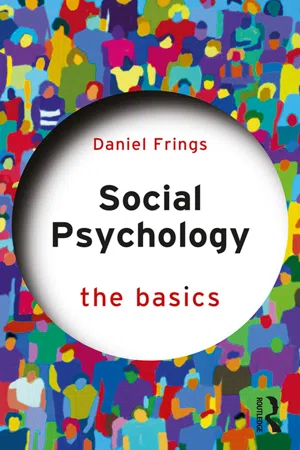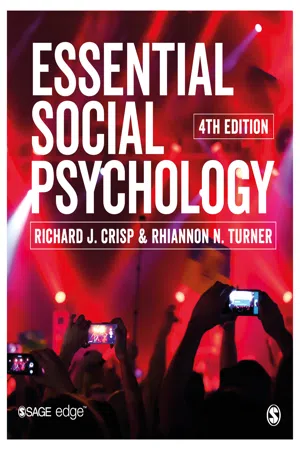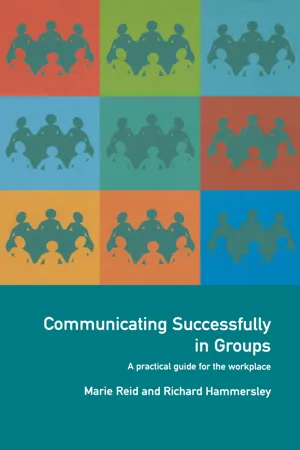Psychology
Social Influence
Social influence refers to the way in which individuals' thoughts, feelings, and behaviors are affected by the presence or actions of others. It encompasses various forms of influence, such as conformity, compliance, and obedience. Social influence can be studied through the examination of group dynamics, social norms, and the impact of authority figures on individuals' behavior.
Written by Perlego with AI-assistance
Related key terms
10 Key excerpts on "Social Influence"
- eBook - ePub
Essentials of Social Psychology
An Indian Perspective
- Shubhra Mangal, Shashi Mangal(Authors)
- 2022(Publication Date)
- Routledge(Publisher)
In its word meaning, the term Social Influence means the type of influence that is social in nature. It, thus, stands for an influence exercised on the part of an individual/group to make the desired change in the behavior of others. Under the impact of Social Influence, people tend to behave differently other than what they would have if left entirely to them. Sociologists and socio-psychologists both consider this phenomenon of Social Influence quite essential and significant for the adjustment of the individuals in their social setup and also running of the social setup itself in a desired way. For understanding the meaning and concept of the term Social Influence let us now think over some of its well-known definitions provided by the scholars and thinkers in this field.Baron and Byrne (2001:318): Social Influence may be defined as “efforts by one or more individuals to change the attitudes, beliefs, perceptions, or behaviors of one or more others”.Avermaet (2004:404): Social Influence is the change in the judgments, opinions and attitude of an individual as a result of being exposed to the views of others.Crisp and Turner (2014:85): Social Influence is an umbrella term. It refers to any effect that another person or group has on your attitudes and behaviors.Barrett (2017:190): Social Influence is an internal or external change in a person caused by the real or imagined pressure from others.The analysis of the preceding definitions may reveal the following things about the meaning and nature of the term Social Influence.- Having, basically, a social nature and feeling the need to remain attached to their social group/society the individuals are prone to yield under Social Influence – introduce changes in the ways of their thinking, feeling and behaving as asked and desired by others who are considered recognizable and valuable by them for this purpose.
- Social Influence has a great potential to bring changes in the behavior of a person or group of persons. These changes are internal (introduced in their ways of thinking and feeling) as well as external (reflected in their acts and actions performed by them in their social encounters).
- eBook - ePub
Social Psychology
The Basics
- Daniel Frings(Author)
- 2018(Publication Date)
- Routledge(Publisher)
Social Influence Theme overviewHow would you behave if told to do something you fundamentally disagreed with? How do revolutionary movements overturn the opinions of the society they exist in? When you see an advert promoting a new product, how good are you at separating the facts from the marketing spiel? Do others invigorate you to work harder, or do you just blend in and slack off? All of these phenomena can broadly be understood as instances where Social Influence comes into play.In many ways, the study of Social Influence encompasses all of social psychology. Recall that the impact of the ‘actual, imagined or implied’ presence of others is part of how we define the field. In essence, when someone’s actions (or something which signifies such actions) changes how someone else thinks, feels or behaves, you can argue Social Influence has taken place. As such, our discussion of Social Influence encompasses almost every page of this book. However, we can also narrow the discussion by looking at how people change the intended behaviour of others (which we discuss in Chapter 6 , ‘Conformity and obedience’) and how we are both recipients of, and targets for, people’s attempts to change our opinions on a given issue (explored in Chapter 7 , ‘Persuasion’).Across these two chapters we will explore how, why and when we conform to others’ demands, the effects of groups on our performance, how society deals with people who won’t conform to the prevailing view and how such minorities can cause major social shifts. We also explore the theory and practice of persuasion by investigating the extent to which we are rational thinkers, how irrelevant information such as mood and colour influence us, and how the science of persuasion is applied to marketing and public policy. - eBook - ePub
- Diana Jackson-Dwyer, Craig Roberts(Authors)
- 2014(Publication Date)
- Psychology Press(Publisher)
Social Influence 7What’s it about?Key termsSocial psychology is about how we interact with other people when by ourselves or when in groups. These interactions help to shape who we are and how we act in subsequent similar and different situations. This helps us to perceive the world in a particular way. It also helps us to understand the world we live in. The area of focus for this broad topic in psychology is obedience – why are some people obedient and why are some people defiant? The factors that may stop people being obedient or change their obedience levels are also considered by social psychologists.WHAT’S IN THIS UNIT? The specification lists the following things that you will need to be able to do for the examination:Define conformity, obedience, social loafing and deindividuationDescribe and evaluate studies into conformity, obedience, social loafing and deindividuationExplain factors affecting conformity, obedience, social loafing and deindividuationExplain factors affecting bystander interventionDescribe and evaluate studies into bystander intervention, including Latané and Darley (1968), Batson et al. (1983), Piliavin, Rodin and Piliavin (1969) and Schroeder et al. (1995)Consider contemporary practical implications of studies and research into Social Influence and their benefits and drawbacksHere is a list of important terms that you should learn in your revision. Try to write definitions for these after reading the chapter, and check your answers in the glossary on pp. 131–136. Essential terms that you must - eBook - ePub
- Richard J. Crisp, Rhiannon N. Turner(Authors)
- 2020(Publication Date)
- SAGE Publications Ltd(Publisher)
5 Social Influence- Social Norms 108
- Norm Development 108
- Conformity 112
- Asch’s Conformity Experiment 113
- Explaining Conformity 114
- Factors that Moderate Conformity 116
- Impact of Influence on Social Norms 120
- Minority Influence 125
- Consistency and Confidence 125
- How Minorities Exert Influence 127
- Obedience 128
- Milgram’s Study of Obedience 128
- Explaining Obedience 130
- Determinants of Obedience 131
- Social Impact Theory 133
- Norms as Nudges 133
- Chapter Summary 134
When, why and how is people’s behaviour influenced by the presence of others? How do other people influence our own behaviour?Social Influenceis all about how our thoughts, feelings and behaviours change when in the presence of others. Social Influence is an umbrella term. It refers to any effect that another person or group has on your own attitudes and behaviours. In this chapter, two types of Social Influence will be discussed: conformity and obedience. Both are concerned with the same outcome: a change in behaviour. They differ in thatconformityis used to describe attitude or behaviour change in response to an implied, rather than explicit, social norm. In contrast,obedienceis attitude or behaviour change in response to a direct, or explicit, order. We will see how both majorities and minorities can exert influence on each other, how there are different motivations for following social norms, and how all these interrelated ideas come together to predict Social Influence in any given context.Social Norms
Norm Development
Some of the very earliest studies in social psychology were on the topic of Social Influence. Sherif (1935) carried out a classic study to investigate how groups might come to have what are apparently consensual and homogenized beliefs. His experiment had two phases. Participants were initially led to believe that the experiment concerned ‘visual perception’, although what Sherif was really interested in was the influence that other people in the context had on reported visual perception. Participants were led to a room which was pitch-black except for a small dot of light on the far wall. The participants’ task was to make 100 judgements as to how far the dot was moving in inches. In fact, Sherif was making use of an established perceptual illusion called the ‘autokinetic effect’. This effect makes a dot appear to oscillate in a dark room when there is no other point of reference. Because there was no actual movement of the dot, the autokinetic effect provided an excellent experimental control: any observed effects on participants’ estimations of how far the dot moved could only be attributable to psychological factors. In this first phase when participants individually made their estimates there was, as expected, some variation in different - Isabella Poggi, Francesca D'Errico(Authors)
- 2022(Publication Date)
- Routledge(Publisher)
2 Social Influence and persuasion Isabella PoggiDOI: 10.4324/9781003029274-3People influence each other in many different ways. In this chapter, starting with our definition of Social Influence, we outline a typology of ways in which people are influenced by others, through overt or covert behavior, the induction of beliefs and emotions, and by words.2.1 Influencing others
Our definition of Social Influence is the following: A influences B when A raises or lowers the likeliness for B to pursue some goal G. In this, our notion somehow enriches and generalizes the one used in classical social psychology, generally only referred to how people's behavior is affected by what is proposed, or more typically imposed, by a majority, a minority, or an authority. The notion presented here is from some point of view more general, because it refers to any influence, both between collective and individual agents, and from other viewpoints more specific, because, while it encompasses various tools of influence (for instance, both beliefs and emotions) it characterizes all influence as aimed at affecting the other's goals (Poggi, 2005a ).Therefore, to understand how people influence other people – how do they induce them to pursue particular goals – we must first wonder: how does a person come to have a goal? And what happens before a goal is pursued? Three phases are relevant in a system's goal decision and management: generation, activation, and choice.2.1.1 Goal generation
The notion of goal generation suggests that a new goal intrinsically rises from an agent's mind, ultimately in one of two avenues, which we can label cognitive and affective goal generation. In the former, a new goal arises from cognitive planning and deliberation and entails the – more or less aware – assumption of a new belief. In the latter, it is some emotion that triggers the new goal.- eBook - ePub
Behavioural Research for Marketing
A Practitioner's Handbook
- Julian Adams(Author)
- 2022(Publication Date)
- Routledge(Publisher)
Chapter 2 How Social Influence creates and sustains behaviourDOI: 10.4324/9781003169932-2CHAPTER OVERVIEW
Key theories: socialisation, social norm theory, pluralistic ignorance, nudge theory, norm following, norm compliance, ethnocentrism, social identity theory, symbolic interactionism, structuration theory and social practice theory.- 2.1 We begin by considering the nature of social norms. Different types of norms and norms in different situations are discussed before looking at the power of social norms to change behaviour.
- 2.2 Next, the role of non-instrumental behaviour and normative influence is discussed.
- 2.3 We then turn to the role of conformity in avoiding negative consequences of not abiding by social norms.
- 2.4 Looking next at social identity we explore how we make sense of the social world by dividing the world into ‘us’ and ‘them’.
- 2.5 In the penultimate chapter, we look at symbolic interactionism and how we ascribe meaning to things based on social interactions.
- 2.6 Finally, we look at social practice theory as a mechanism in which to understand everyday habitual behaviour.
Introduction
Social Influence is a critical force in human behaviour. To put this in perspective, whenever people interact with one another, they influence each other’s attitudes, beliefs and behaviours. To a large extent, the expectations of others influence how we behave. Further, the very act of interacting with others helps give meaning to things and allows us to learn about ourselves and the social world we inhabit.Why is Social Influence important in behavioural research?
Upon reading this chapter, the importance of the social context of behaviour will become clear. In market research, there can be a tendency to focus more on the individual and less on the context in which behaviour originated, simply because that is what is most immediately obvious to the researcher when observing behaviour. Gaining an appreciation of societal influences on behaviour is critically important in our understanding of why people do what they do and how they seek to rationalise that behaviour. As we will see, understanding the social context of behaviour can be a powerful tool with which to influence behaviour. - eBook - ePub
- Miles Hewstone, Wolfgang Stroebe, Miles Hewstone, Wolfgang Stroebe(Authors)
- 2021(Publication Date)
- BPS Blackwell(Publisher)
8 Social InfluenceMiles Hewstone and Robin MartinCHAPTER OUTLINE
- INTRODUCTION
- CLASSIC EVIDENCE OF Social Influence AND THE POWER OF SOCIAL NORMS
- WHY DOES Social Influence OCCUR?
- TYPES OF Social Influence
- CHAPTER SUMMARY
ROUTE MAP OF THE CHAPTER
This chapter considers Social Influence broadly, and how it can be understood in terms of fundamental motives. First, we discuss classic research on the key role of social norms in Social Influence. In the second part of the chapter, we ask why people succumb to Social Influence, highlighting types of Social Influence and the motives of the person being influenced. In the third part of the chapter, the heart of the chapter, we consider four major research topics in Social Influence. We introduce theory and research on induced compliance, the influence of numerical majorities and minorities, group decision‐making and obedience. Throughout, we will see that Social Influence is an ambivalent concept. On the one hand, it is the glue of society; it makes things work, and society would be utterly chaotic without it. But on the other hand, it can be a dark force, responsible for some of the most extreme, even immoral, forms of human social behaviour.INTRODUCTION
On a typical day most of us will be exposed to a large variety of Social Influences. You might be on your way to a lecture, when you see three of your friends turning away from the psychology department, towards town. Although no one has tried to persuade you, you are influenced to follow them, and drink coffee instead of attending the lecture. Why? As you later sit sipping your cappuccino, the topic turns to the use of animals in experimentation, and you find yourself out of line with your three friends, who all try to convince you that such studies are unnecessary and unethical. You try to counter‐argue them, doing your best to offer ‘strong’ persuasive counter‐arguments. Then you head back to the university and run into the lecturer whom you failed to meet yesterday as agreed; she tells you to come and see her that afternoon; meekly, you obey. - eBook - ePub
- Nicky Hayes(Author)
- 2017(Publication Date)
- Routledge(Publisher)
Chapter 6 Contents Presence of others The effect of groups Conformity and acquiescence Obedience, power and control Re-evaluating obedience and agency Individuality and de-individuation Crowds and mobsSocial Influence
6
From the beginning of this book I have talked about people as being social animals, and I hope I have shown just how fundamental this fact is to how we interact with other people. But being a social human isn’t only about belonging to social groups; we are strongly influenced just by the presence of others, whether they are in the same group as us or not. Indeed, in some situations, other people can exert quite a lot of control over how we act — even though we don’t know them, or are just hearing from them through the internet. In this chapter, we will be looking at some of the ways that other people directly affect our behaviour.PRESENCE OF OTHERS
One of the early discoveries made by social psychologists was that people can influence our behaviour just by being there when we are doing something. Sometimes, other people’s presence can mean that we do things better — a phenomenon known associal facilitation. Triplett (1898) demonstrated social facilitation by asking children to turn a fishing reel as fast as they could for a set period of time. The children turned it faster and more energetically if there were other children in the room doing the same thing.Coaction and audience effects
The reason, Triplett believed, was because they felt they were competing with one another. But Allport (1920) found that even if people were directly instructed not to compete, the same results would happen. In Allport’s study, the participants were college students solving multiplication problems; and Allport found that they even worked better if they could just see other people working, even if it wasn’t on the same task. Simply being active while others are active nearby — coaction — seems to be a reliable social effect. - eBook - ePub
Communicating Successfully in Groups
A Practical Guide for the Workplace
- Richard Hammersley, Marie Reid(Authors)
- 2014(Publication Date)
- Routledge(Publisher)
8 Social Influence in groupsHow people behave in a group depends on both the other people present and on some basic rules of Social Influence. Group behaviour is not just the behaviour of each person, added together. This chapter will look at the basic processes of Social Influence and indicate how these affect behaviour in groups.Objectives
By the end of the chapter you should:- Know the main forms of social power.
- Appreciate the relative nature of authority and the difficulties of defining leadership.
- Understand the main mechanisms of normalisation, conformity, obedience and de-individuation.
Sources of individual power in groups
Power is one important aspect of Social Influence. Indeed, when someone can influence others then we often say that he or she has power over them. Power comes from both really having sources of power and from display of power. Often, display of power is more than enough in itself.Physical power
Power can come from simple physical force – do what I say, or I’ll hit you, or get my soldiers to hit you – or from the threat of such force, but physical power can also come without any such threat. Taller people tend to be more successful in life, along with a minority of very short people who are believed to overcompensate. Many people would be annoyed to be judged on their size rather than their abilities, but does tallness suggest physical power and make others more likely to listen to a tall person? Studies in which people rate others find that taller people tend to be rated as more intelligent and capable.In the workplace – other than in sports and the armed forces – real physical power is rarely relevant and people who are openly physically intimidating are unlikely to succeed, but suggesting physical power may influence others, even if the display has no real basis. There has been advice to the business community on power dressing – wear dark colours, look tall, fit and serious – and power lunching (eat food that suggests predation and health, such as meat and raw food). One has to be careful not to overdo such displays and be seen as a crank or show-off, rather than as powerful. Senior managers may wear expensive dark suits, but if the junior clerk copies them then he may be teased. Still, when entering a new group it is useful to give some thought to your physical presentation of self (see Chapter 3 - eBook - ePub
- Daniel Richardson(Author)
- 2014(Publication Date)
- For Dummies(Publisher)
I immediately discovered that all uniforms aren’t created equal. It was absolutely crucial that the turn-ups on your trousers were of precisely the right size. I had a vague idea that this was important, and Mum had lovingly stayed up the night before stitching a pair into my trousers. To my horror, on the first day I saw that mine were almost an inch too short. This was a difference of nightmarish magnitude between my trousers and those of the effortlessly cool, lank-haired boys whom everyone seemed to admire.Getting Along: Ways People Conform
The textbook definition of conformity is changing your behaviour to match the opinions or actions of others. It’s subtly different to other forms of Social Influence that can cause a change in behaviour:- Obedience: When you respond to a direct order from someone in a position of authority (see Chapter 12 for more – and that’s an order!). So if a teacher tells you to line up at school, that’s obedience.
- Compliance: When you make a change in response to direct pressure from others. If a school bully threatens you and you hand over your lunch money, that’s compliance.
Absorbing other people’s opinions
When people live in a community, they tend to share beliefs and opinions. Of course, not every agrees all the time, but there is a tendency for opinions to conform. This is one reason (though there are others) that political maps of the country coloured by voting patterns tend to be reasonably similar between elections. Of course, some places switch from red to blue, but many areas are stable across the years in terms of political preferences.Untangling the reasons for this conformity in opinion is very complicated. Social psychologists have studied the phenomenon in field studies of college students. They are a good test case since students come from all over the country, live together for three or four years, and then (usually) leave. Psychologists have tracked how students’ opinions shift as a result of living together for this short period of time.
Index pages curate the most relevant extracts from our library of academic textbooks. They’ve been created using an in-house natural language model (NLM), each adding context and meaning to key research topics.









